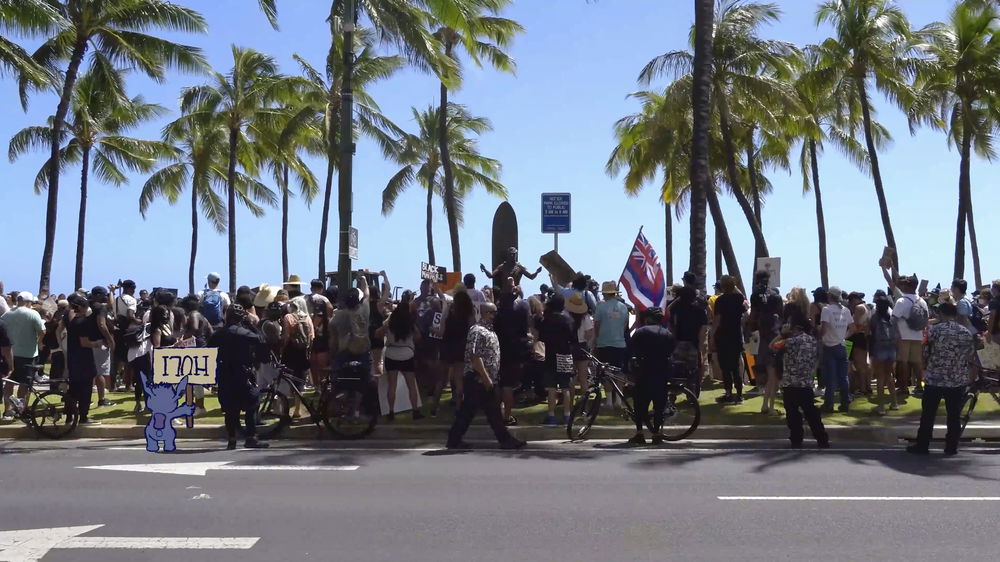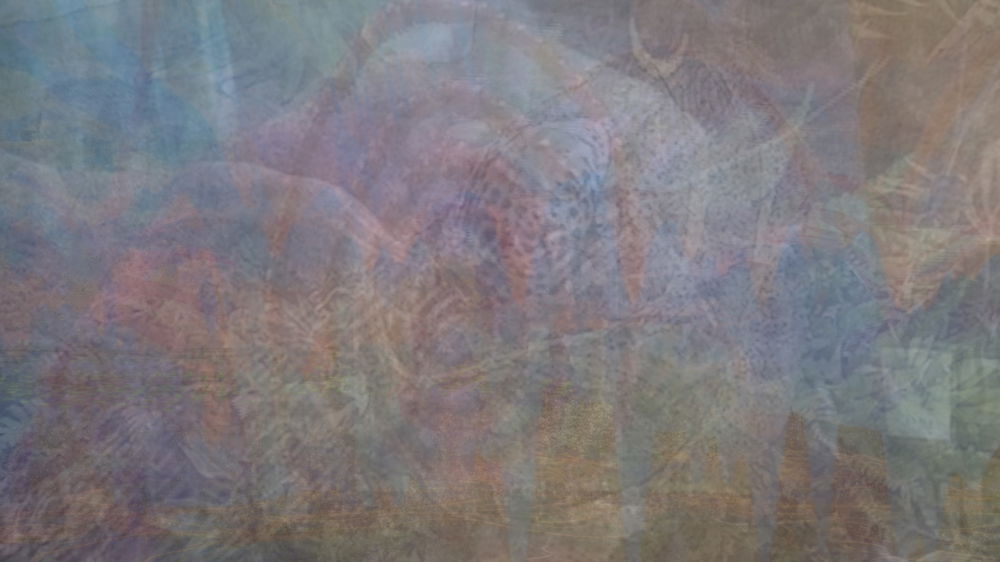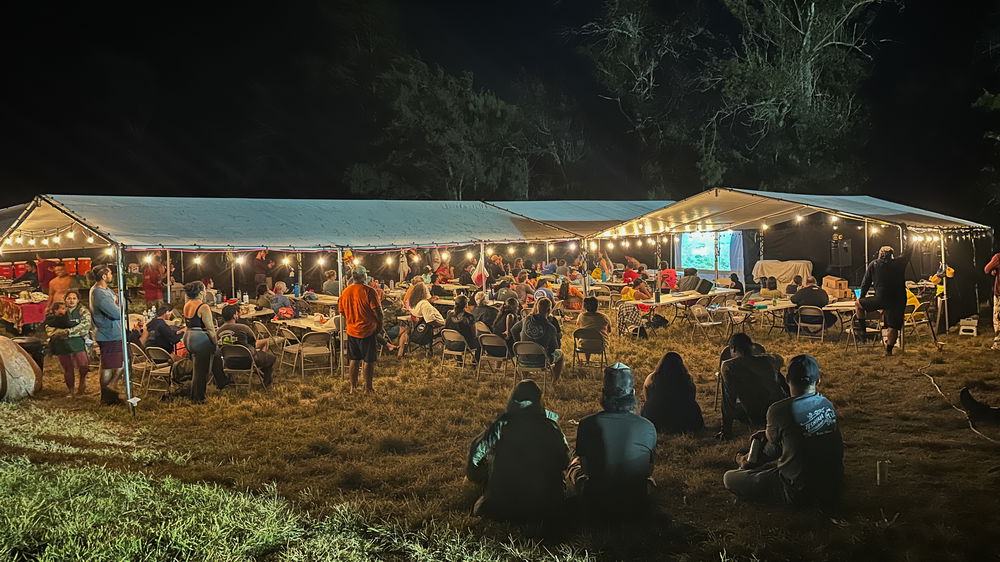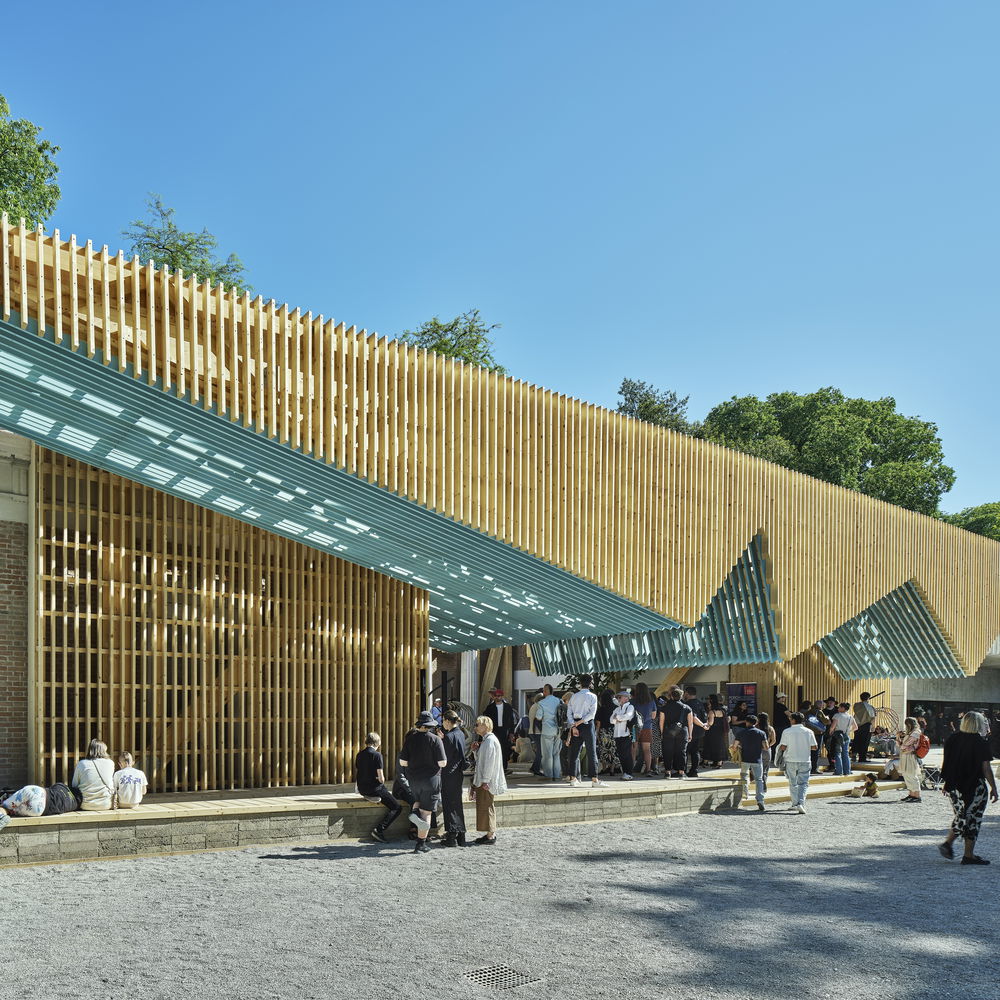Making a Third Space: A Conversation with kekahi wahi
Grassroots film initiative kekahi wahi on fostering intergenerational exchange and caretaking images

no ke kai ka hoi ua aina by kekahi wahi, 2022. Video still. 11 minutes.
Courtesy of the artists.
Dreaming of a third space and refuge led artists and filmmakers Sancia Miala Shiba Nash and Drew K. Broderick to create the collective kekahi wahi. In this interview, they share how kekahi wahi has evolved over the years and the importance of fostering community. Shiba Nash explains her work in collaboration with fellow Hawaiian film collective, Nā Maka o ka ‘Āina, about rematriating archival footage and how images of ancestors should belong to their respective descendents. Broderick digs into the importance of collaborative and intergenerational projects, such as their eight-part film series and upcoming publication, i nā ki‘i ma mua, nā ki‘i ma hope / images at front, images at back.
Sól Casique: Sancia, in an interview, you mentioned that in college you had a dream that impacted your career path to go back home. I was wondering for both of you, are there any dreams that you've thought about a lot lately or that have had an impact on you both?
Sancia Miala Shiba Nash: I feel like the dream space has always been where I can meet with ancestors. It’s where they share stories with me and strategies to remember. Most recently, a work that I did this past year for the Hawaiʻi Triennial 2025: ALOHA NŌ was guided by my dreams. I called it Kuroshio (Black Current). The Kuroshio is an ocean current that flows up from the Philippines, past Taiwan, Okinawa, and Japan, before joining other currents that make their way to the Aleutian Islands, and then down to Hawaiʻi. This installation was trying to trace ancestral relationships between some of these archipelagos.
For me, a catalyst for thinking about these relationships across time was a dream that I had during my mother's passing when I was a young teenager. It was a recurring dream that I had of sailing and drifting on a canoe towards these islands. I feel that dreams are planted within us at certain points in our lifetime, and then they grow in unexpected ways, not haunting us, but revisiting us over and over. And then, if we are willing, they can manifest in our work.
Drew K. Broderick: The dreams that have impacted me lately as an artist, curator, educator, writer, and collaborator have all been your dreams, Sancia. Learning from your dreams and thinking through how those lessons can be shared in the work that we do together has been really meaningful. You mentioned meeting with your ancestors in your dreams, but what does it mean to honor someone else's ancestor that we never had a chance to connect with in waking life? And how might we come to know them in different ways through an experience like a dream or a night vision or a memory that feels so present that it takes a shape or a form?

i nā kiʻi ma mua, nā kiʻi ma hope, program 8: aloha, curated by kekahi wahi (Sancia Miala Shiba Nash and Drew K. Broderick), 2024. Composite image. 52 minutes. Hawaiʻi Contemporary's Art Summit 2024, Honolulu, O'ahu.
Courtesy of the artists.
Sól: It's such a powerful tool. Dreams transform our realities and unite so many of us, our ancestors or our friends, even people we don't really like. There's also breakthroughs and epiphanies. I know with this amazing collective, both of you have birthed and shaped it throughout the past five years since 2020. How have you seen it evolve throughout that time?
Drew: Our personal relationship, and also our creative collaboration which has grown into a much larger effort than either of us ever anticipated, developed early on through a series of intense, interconnected dreams that the two of us were having across the Pacific Ocean. At the time, Sancia was in Ehime, Shikoku Island with her family and I was in Honolulu, Oʻahu with my family. Shortly after we had this shared experience we decided to form kekahi wahi, a grassroots film initiative committed to documenting transformations across the Hawaiian Islands and sharing stories throughout the greater Pacific.
Part of that decision came out of our desire for a third space or a space that was neither here nor there, but somewhere in between. kekahi wahi quickly became that somewhere, a safe space, a refuge for many, in particular, for family, friends, and mentors — and at times lovers and even strangers — to come together and collaboratively research, write, curate, make, share, and talk about documentary, experimental, and non-narrative filmmaking. In Hawaiʻi, where we live and work, there aren't many spaces like that, especially for creative practices that deviate from inherited or established norms.
Sancia: kekahi wahi is really a web of relationships that began between the two of us and then just spread out from there. Even thinking about the work that we've created together over the past five years, it went from being no budget projects to actually having at least a shoestring budget to be able to share with our friends and family and bring on more collaborators.
In that sense, our productions and even our processes have been able to expand. In the beginning, we were making a lot of experimental oral history videos out of a need to document elders that were towards the end of their careers and lives. We really felt a sense of urgency to document their legacies and record their stories. Now we're moving into a space of being inspired by all the work that has been done by previous generations and wanting to move it onward in new ways and directions.
“kekahi wahi quickly became that somewhere... to come together and collaboratively research, write, curate, make, share, and talk about documentary, experimental, and non-narrative filmmaking.”
Sól: That makes a lot of sense because of the many communities that both of you share and touch with all your different projects. I love the variety: the weaving workshops, the discussions, the film screenings. I was really inspired to see young people and elders. How have you nurtured and cultivated that intergenerational programming?
Sancia: Well, one big project that we've been working on for the past couple years is i nā ki‘i ma mua, nā ki‘i ma hope. It's an eight-part screening series and soon-to-be publication that considers how the images of our pasts inform the images of our futures. This project is really trying to trace a genealogy of documentary, experimental, and non-narrative filmmaking of Hawaiʻi across multiple generations from the early 1970s to mid 2020s. When we realized that there wasn't a dedicated venue for this kind of filmmaking, we tried to cultivate that and create opportunities for folks to share films and have conversations that we felt were absent from the larger scene.
Drew: In Hawaiʻi, we hold space and carve out time for intergenerational collaboration and knowledge transmission in so many different ways. One way is through extended family. There are a lot of multigenerational households here in the islands. Cost of living is high, annual income is low. Being raised by grandparents, aunties, and uncles is a cultural practice and also a response to the difficult economic conditions that define daily life. So, intergenerational collaboration is a necessity here, just one of many strategies for survival.
Sancia and I always try to situate the work that we do in relation to the work that folks have done before us, and also hopefully the work that folks will do after us. We can't claim intergenerational collaboration as something that we do. It's something that folks in Hawaiʻi do. In that sense, it's not unique to our practice at all. It's just a way of being in relation here. We are simply carrying on a practice of this place that has been modeled for us that we feel is aligned with the values of our work.
Sól: Thank you both for sharing that. I'm just so thankful for the connections that we have to each other and also to the land, wherever that may be. Especially right now, being connected to each other and holding each other is what will sustain us. How do you hope your work and intention that you put into this work will influence and guide future generations, especially with the upcoming publication that Sancia mentioned earlier?
Drew: It's been amazing to get to a place where we can finally imagine multiple futures and pasts instead of just the future and the past. Communities are plural too. We hope that i nā ki‘i ma mua, nā ki‘i ma hope / images at front, images at back (2025) will become a channel. A way for future generations of Hawaiʻi artist-filmmakers to commune with past generations. For us it is also a small gesture of gratitude, a way to celebrate and honor the communities that we’re a part of and all those who nurture and care for them beyond advancing their own careers as individual artists or filmmakers.
i nā ki‘i ma mua, nā ki‘i ma hope / images at front, images at back is structured around an open invitation to folks who participated in an eight-part screening series of the same name that kekahi wahi curated, organized, and presented between 2022 and 2024. The publication gathers together a variety of material — reflections, poems, scores, scripts, commissioned essays, transcribed and edited roundtable discussions, etc. It’s also worth noting that the project couldn't have happened as it did without the unrestricted funding that kekahi wahi received from United States Artists.

Event documentation of Ahupuaʻa, Fishponds & Loʻi: Maui, presented by Hoʻomau Nā Maka o ka ʻĀina and Kuaʻāina Ulu ʻAuamo at Hui Mālama Loko Iʻa, Kapoho, 2024. Kapoho, Waihe'e, Wailuku, Maui.
Photo by Sancia Miala Shiba Nash.
Sancia: We are very interested in reinterpreting old stories in different ways, in keeping them alive and carrying them onward. Another project we are working on now is Ahulau, an experimental short film that was commissioned by the COUSIN Collective.
Ahulau is set on the island of Maui, and it follows two couples that are playing a round of golf. As the afternoon unfolds the histories of the land beneath their feet bubble forth and the group must reckon with the traces of a battle between warring chiefs that took place in the same location 250 years earlier. It’s so important for us to continuously reanimate stories of old, to bring them to life in new ways. We are imagining it as a “fever dream” to embrace the possibilities of hallucinations, both individual and collective, in all aspects and phases of the project. It’s gonna be fun!
Sól: I definitely am looking forward to that project. Drew, you have mentioned in previous interviews that you're not bound by any particular discipline, material, or way of working. Are there any mediums or ways of storytelling that either you haven't done yet or you want to explore more?
Drew: Yeah, definitely. Before I speak to that, I just wanted to come back to the question that you posed earlier about influencing or guiding future generations. I think a lot of what Sancia does can be understood as an embodiment and demonstration of the way in which varied efforts of pasts, presents, and futures can be woven together and moved onward by folks that are a part of younger generations.
The two of us are a decade apart, but a lot of the work that she does is with older filmmakers, much older, in their seventies, even early eighties. There's something really interesting about the way that she supports their practices as a part of her practice. And I think there's something there for filmmakers of younger generations to pay attention to and learn from.
Sancia: Drew and I work very closely with Nā Maka o ka ‘Āina (Joan Lander and Puhipau), which is a video production team that, for more than thirty years, documented Hawaiian culture, language, as well as land and water rights struggles beginning in the early 1980s. Through their intersectional collaboration Auntie Joan and Puhipau created a vital resource of 6,000 videotapes. Through Hoʻomau Nā Maka o ka ʻĀina, a program of Puʻuhonua Society, a Native Hawaiian women-led not-for-profit organization based in Honolulu, I am helping to support Aunty Joan and a larger process of digitizing and making publicly accessible material from Nā Maka o ka ʻĀina’s archive.
One aspect of the project that is particularly meaningful for me is returning unedited and often unseen audiovisual recordings back to the places, communities, and families that were recorded decades ago. We do this by collaborating with community leaders and organizations to present exhibitions, resource desks, community screenings, workshops, and discussions. We also give hard drives with all the unedited material as well as searchable transcripts back to descendents of those who appear in the original recordings so that they can reconnect with and learn from their ancestors in the present. We need to care for the stories that have been made already and bridge our pasts with our futures so that stories, peoples, and places remain connected to one another in some way, shape, or form.
“We can't claim intergenerational collaboration as something that we do. It's something that folks in Hawaiʻi do. In that sense, it's not unique to our practice at all. It's just a way of being in relation here.”
Drew: Totally. It's not every day that a descendant of someone who was recorded forty years ago gets to experience their ancestor who they never met in the same place that they were speaking back then. There's something very profound about ensuring the continued existence of beliefs, teachings, practices, and stories by giving recordings back to the places and the peoples that they came from.
To return to Sól’s question about working across different disciplines or utilizing different materials, I think this approach is part of the resourcefulness of island living. As artist, poet and, activist Uncle ‘Īmaikalani Kalāhele often says, “Use what get!” In terms of exploring new mediums, I don't have a good ear, but I’ve been trying to listen more. Sancia is an aspiring DJ and her remixes that mashup Hawaiian and house music have gotten me more and more excited about playing around with sound.
Right now I’m working on a recording for an exhibition that opens later this summer at Gallery ‘Iolani, Windward Community College curated by artists and educators Kapulani Landgraf and April A.H. Drexel. The recording is of an interstate highway as heard from within one of its viaducts as cars pass over it and the sounds of the structure reverberate throughout the surrounding rural valleys. Part of not being bound by any discipline, material, or way of working is also about embracing the joy of learning, of being an amateur and never developing expertise in a world where that's what we're told we're supposed to do.
Sól: Sancia, you mentioned your preservation efforts with Hoʻomau Nā Maka o ka ʻĀina earlier. Often when preservation is mentioned or pushed, it's to cover up its capitalist intentions. What does true preservation mean to you? Are there any other definitions or feelings you two have towards preservation?
Sancia: Drew and I occasionally venture into institutional environments to try and locate certain images for projects that we're working on. And we often come up against gatekeepers and obstructionists, folks who would rather suffocate recordings than breathe life into them. They’re just locked away underground and if they ever do see the light of day again it costs hundreds of dollars, sometimes thousands, and takes many months or even years to do so. Having said that, spiritual guardianship is a really important concept and practice for me. Māori filmmaker Barry Barclay talks about this idea that as filmmakers we're always gifted images. And in that way, we don't own them. We're just the caretakers of those images. And for me, I believe that one day when the time is right those images can be gifted back to descendants and other folks who are committed to honoring their spirit and memory by carrying them into shared futures.
Drew: Institutions aside, when a community or a culture has suffered immense loss, there are often demands from within to preserve all we can. It's easy to get caught up in that feeling, that because we've lost so much we need to do everything we can to preserve things as they are. But part of preservation for me is also about holding that knowledge or that material or that practice in a way that allows it to continue to change and to have, as Sancia said, a life of its own beyond what we impose onto it because of what we have endured. Sometimes preservation inadvertently becomes a factor that limits our own development or evolution or growth as a community or people.
As artists, filmmakers, and community members actively engaged in acts of preservation we also need to be adapting and changing. That's really difficult for younger generations here in Hawaiʻi because there's so much pressure from older generations who have struggled in different ways than we have to perpetuate their culture. Criticism from elders can be tough, especially when work is quickly dismissed as irreverent, youthful, or exuberant. But no matter what, we need to keep moving in ways that question the seemingly fixed nature of culture and our creative expressions.
Related artists
-
kekahi wahi (Sancia Miala Shiba Nash and Drew K. Broderick)
Grassroots Film Initiative



